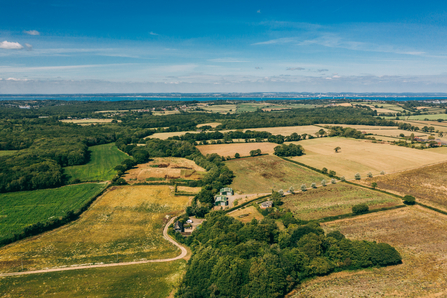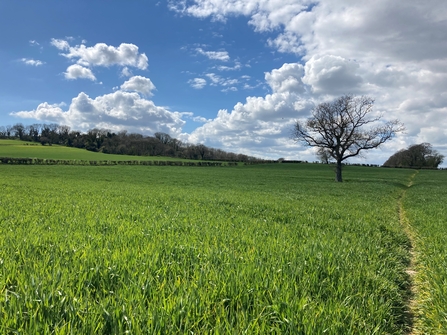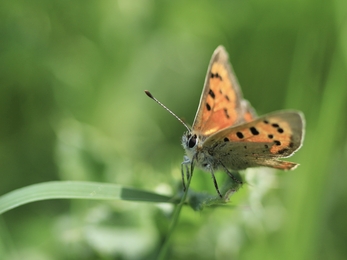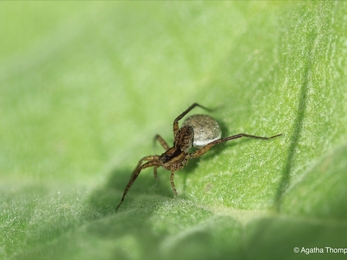Ecological monitoring involves carrying out a series of wildlife and environmental surveys to provide information about a site and how it may best be managed. Surveying certain wildlife, which act as ‘bioindicators’, can provide comprehensive information on how these nature reserves are supporting wildlife, and how habitats are changing over time. Bioindicator species are sensitive to their surroundings, meaning they respond quickly to changes in their habitat. The wildlife we are monitoring at our rewilding sites include bats, birds and invertebrates.
Celebrating Global Rewilding Day
Wilder Duxmore Farm 2022 © Agatha Thompson

© StrongIsland
Wilder Little Duxmore
Ecological monitoring at Little Duxmore began in 2021, and we’ve just completed the second year of monitoring. We have, therefore, been able to make our first comparisons to the baseline year and form a picture of how the site may be improving for wildlife. These are only preliminary results however, and a few more years’ worth of data will be needed to provide robust conclusions about the effects of rewilding.
Results from our second year of ecological monitoring at Wilder Little Duxmore include:
- Significantly increased bird counts at Wilder Little Duxmore, with seven new species recorded including: coal tit, raven, stonechat, reed bunting, sparrowhawk, wheatear and herring gull – the latter four of which are rare species placed on the Birds of Conservation Concern 5 list. This indicates that Wilder Little Duxmore provides important resources for birds, likely in the form of foraging opportunities and refuge. There is also evidence of breeding birds using the site, with calling birds recorded during all surveys.
- Evidence of a wide range of bat species, including four UK Biodiversity Action Plan Priority Species. One of these, the barbastelle bat, is listed as Near Threatened on the IUCN Red List. More activity was recorded in 2022 than in 2021 for two species: Nathusius’ pipistrelle and brown long-eared bat. These species were also recorded at more locations across the site, hopefully indicating that as the site becomes more complex and varied, suitability for a wider range of species with different ecological strategies will increase.
- Increased species diversity for butterflies, with six new species recorded in 2022 including the endangered Glanville fritillary and chalk hill blue, which is classed as vulnerable. Total butterfly counts across all surveys decreased, but were higher during April and May than at the same time in 2021. This is likely due to the challenges presented by last summer’s drought, which brought the driest July in England since 1935 and very little rain for the rest of the summer. This was evidenced at Wilder Little Duxmore by the parched fields and drying up of the stream. These conditions would have reduced the carrying capacity (the viable population number) of the site. However, the increased species counts hopefully indicate the improved suitability of the site providing suitable habitat for a wider range of species, despite the difficult conditions in 2022.
- Decreased bumblebee activity with stable species counts. The dry conditions also impacted bumblebees, with April and May levels higher than in 2021 before decreasing from July onwards. It’s hoped the summer of 2023 will not bring such dry conditions, and there are plans for increasing water availability at Wilder Little Duxmore either through pond creation or works to retain water from natural sources.
- A new species of cricket was recorded: the speckled bush cricket. Field grasshopper and Roesel’s bush-cricket also experienced statistically significant increases, however total activity decreased.
Wilder Nunwell
In 2022, baseline ecological monitoring began at Wilder Nunwell. In the first year after being removed from agriculture, 60 bird species have already been recorded. This includes 28 species listed on the Birds of Conservation Concern 5 list, including Dartford warbler, snipe, merlin and yellowhammer. In 2023, territory mapping will be carried out for yellowhammer, to help us further understand how this species is using the site. As many as 23 butterfly species have also been recorded at Wilder Nunwell, including the endangered wall brown and small heath and chalk hill blue, both listed as vulnerable, as well as nine species of bumblebee.

© Agatha Thompson
Environmental monitoring
Soil surveys and nutrient sampling in the streams at both Wilder Little Duxmore and Wilder Nunwell have helped us to form a picture of how nutrients are being stored and leached from the sites. High levels of some nutrients have been recorded due to previous use as arable and poultry farms. The previous application of fertiliser at both sites has been contributing to the very high levels of nutrient pollution in the Solent. High inputs of nutrients such as nitrogen and phosphorus to our water environment are causing eutrophication. The resulting blooms of green algae smother some of our most threatened marine habitats, including seagrass meadows and saltmarsh, which causes rapid loss and deterioration. Since being taken over by the Trust, no further input of fertiliser has been made at either site, so no additional nutrients are being added to the system. Over the next few years, nutrients in the soil will continue to leach out into water courses, however, levels will eventually be reduced and should decline over time.
Summary
Ecological monitoring is an essential part of rewilding, as it informs land managers of how a site is changing and how it may best be supported through management. Surveys will continue annually at the Trust’s rewilding sites, and results from Year 3 at Little Duxmore and Year 2 at Nunwell will be reported in early 2024.
This is only the beginning for these two rewilding sites. This year, we will welcome livestock onto Wilder Little Duxmore once our fence installation is complete. The plan is to introduce a small number of cattle, horses and pigs as each species has different grazing habits and creates different ecological niches. For example, pigs have great potential to create wet patches and bare ground through their wallowing and rootling behaviours and this provides ideal habitat for invertebrates, birds and plants that are specialists in wet or bare ground.
We have also tilled some small strips in the fields to maintain disturbed ground after the discovery of rare arable weeds. Turning over approximately only the top inch of the soil maintains this microhabitat and allows these species to thrive. Grazing will also help with these species as livestock can also create an interesting mosaic of patches of bare ground.
We are looking forward to continuing our conservation work at Wilder Nunwell too, but for now we are fortunate enough to be working with the Nunwell Home Farm (a regenerative farm) that are already using their rare breeds of cattle and pigs to graze the land.






